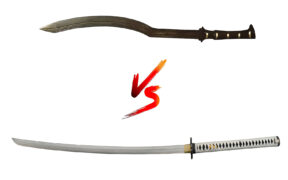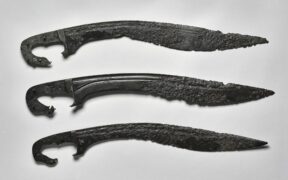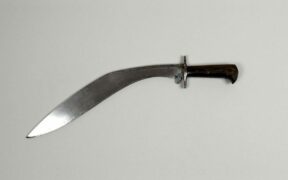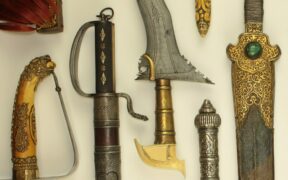Our content features commercial links to our products, committed to transparent, unbiased, and informed editorial recommendations. Learn More
Khopesh: A Guide on the Egyptian Sickle Sword
NO AI USED This Article has been written and edited by our team with no help of the AI
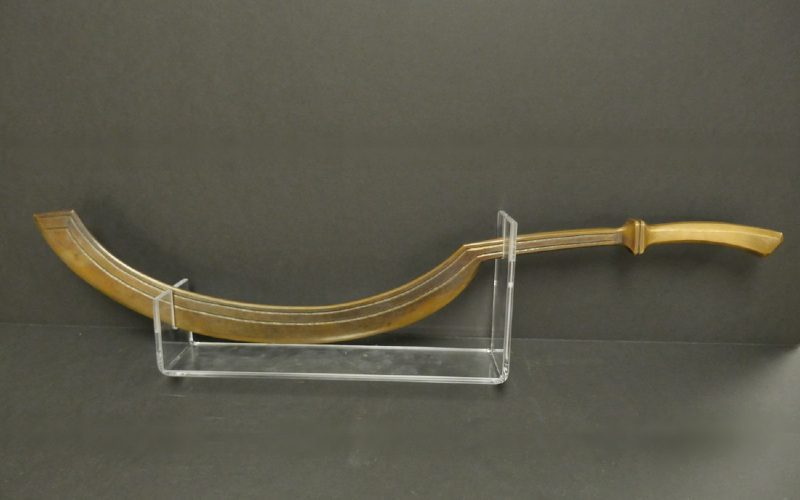
One of the most iconic weapons of ancient Egypt, the khopesh is recognized for its curved blade for slashing and hooking an enemy’s shield. Also known as sickle
This article highlights the unique characteristics of the Egyptian khopesh, its origin, and its significance in ancient Near East history.
Characteristics of the Khopesh Sword
The Egyptian khopesh design is somewhere between a battle ax and a
Type of Metal
The early Egyptian
Blade Shape
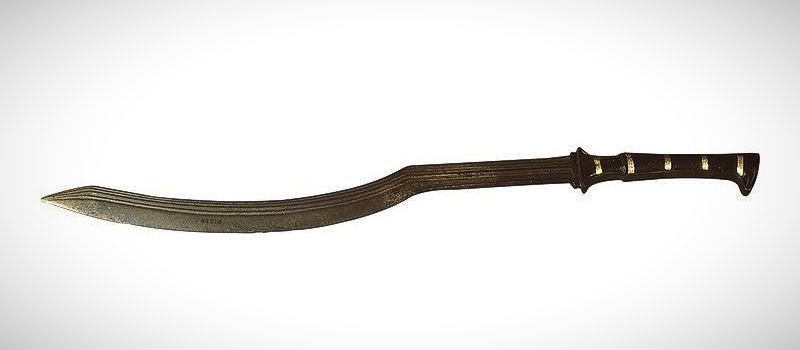
The khopesh is straight until the last half of its length and sweeps out into a curved blade. Unlike a sickle with a sharpened inside curve, the khopesh has its cutting edge on the convex side. The unique shape of the curved blade made it efficient for slashing, hooking an enemy’s shield, and tangling an opposing weapon.
Size and Length
Usually forged in one piece of metal, the khopesh generally had an overall length of about 50 or 60 centimeters. Some modern replicas are more than 60 centimeters long, with a blade length of around 45 centimeters.
Handle and Sheath
Bronze isn’t the most durable metal, so early Egyptian sickle swords were cast in one solid piece including the handle and the blade. Instead of a wooden scabbard, modern replicas often come in a leather sheath with belt loops and buttoned straps.
Facts About the Egyptian Sword
The term khopesh means the foreleg of an animal, especially an ox, a reference to the shape of its blade. Here are the things you need to know about the Egyptian sickle
In ancient Egypt, the khopesh served as a symbol of strength and royal power.
Several Egyptian rulers wielded the khopesh, associating the weapon with royal power and strength. In a famous smiting scene, the Egyptian queen Nefertiti was depicted wielding a khopesh against a female prisoner. Still, Ramses II, also spelled Ramesses, was the first pharaoh to be depicted wielding the Egyptian sickle in battle.
The Egyptian khopesh had some ceremonial roles.
In Hatshepsut’s mortuary temple at Deir el-Bahri, the soldiers were portrayed wielding khopesh swords. However, the Egyptian swords were likely carved from wood rather than bronze-made, suggesting their ceremonial role at swordplay during the funeral rites of a pharaoh. The khopesh also appears in symbolic scenes such as the dismemberment of enemy prisoners, a pharaoh driving a chariot into battle, and smiting,
The khopesh probably evolved from the epsilon ax, not from farming sickle.
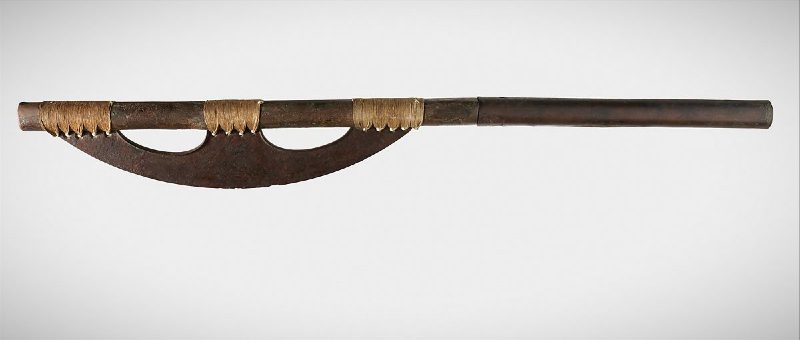
Early khopeshes were very similar to the epsilon axe, except that the handle was metal rather than wood. The epsilon axes featured a blade resembling the Greek letter of that name. Some khopesh blades were shallow and suited for slicing, while others were deep and better for chopping.
On the other hand, the early farming sickles were not made of metal, and were created by embedding microliths in wood, suggesting that the khopesh could not have evolved from them. Also, the sickle is sharpened on its concave edge, but the Egyptian
The khopesh is also known as the Canaanite sickle
The khopesh is closely associated with Egypt, but the manufacturing technique of the weapon likely came from Canaan—a region that encompasses all of Palestine and Syria. The tribes who lived near Mesopotamia also used the sickle
Khopesh-like sickle swords also appeared in northern Mesopotamia.
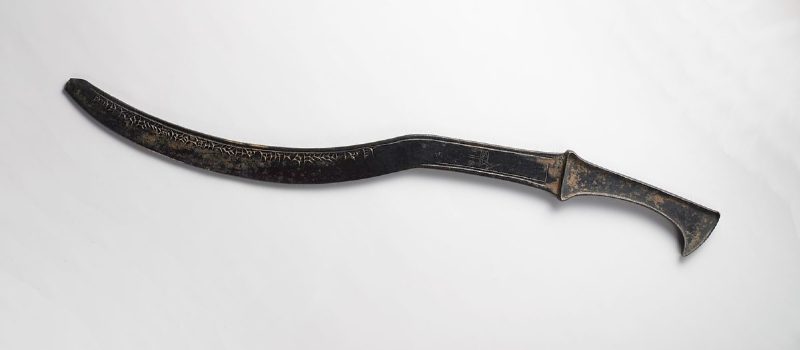
Apart from the Egyptian pharaohs, the Assyrian king Adad-nirari I, who reigned from 1305 to 1274 BCE, owned a sickle
Like several Mediterranean and European swords, the Egyptian khopesh was casted in one.
Compared to copper, bronze was easier to cast and hammer into complex shapes. It was a harder metal, more suited to hold a good edge. The handle and blade of the Egyptian khopesh were typically casted in one single piece. The Mediterranean and European swords were also casted, but they often featured a disk pommel hammered out at the base of the hilt.
The Egyptian khopesh influenced the swords of other cultures.
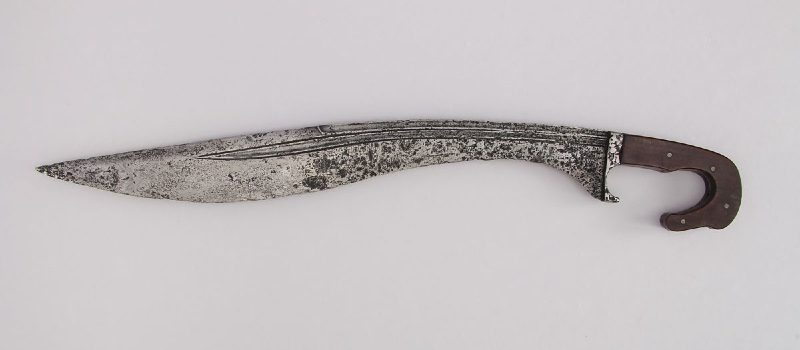
In Ancient Greece, the Greeks used kopis, a heavy knife with a forward curving blade, for animal sacrifice and ritual slaughter. Many scholars suggest that the name kopis may have been derived from the Egyptian word khopesh. The Greek kopis is often compared to the Iberian falcata with a double-edged blade.
The scimitar was likely modeled based on the Egyptian khopesh.
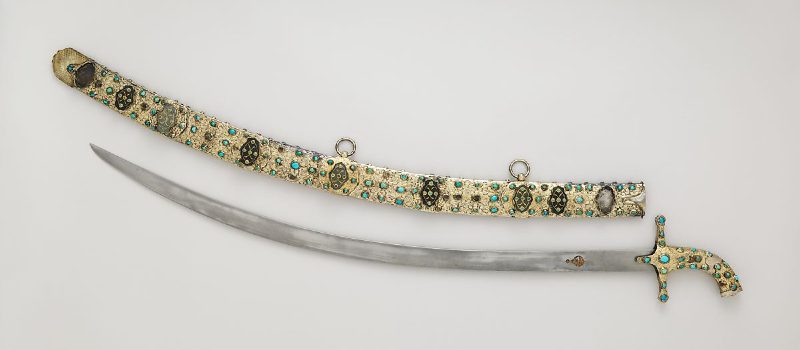
Used mainly by Arabs and Turks, the scimitar has a curved blade, though the term may collectively refer to curved swords used in Middle Eastern countries.
Like the khopesh, the scimitar is sharp only on its outer edge and widens toward its pointed tip. It is interesting that the cutting edge on the convex side has survived in other curved swords such as the Nepalese kukri, Japanese katana, and Albanian yatagan.
History of the Egyptian Khopesh
Egypt adopted innovations of military power from other cultures in the ancient Near East, including the khopesh
Predynastic and Early Dynastic Periods
Throughout prehistory, stone weapons had been serving humanity, so the metal revolution during the Bronze Age changed everything. Copper was the first worked metal from the Middle East, and weapons made from unalloyed copper appeared around 3000 BCE. However, the earliest known examples of sickle swords come from Chaldea—an ancient region of Babylonia and modern southern Iraq.
Eventually, a form of bronze was created by alloying copper with arsenic. Believed to have happened in Sumer, copper was later alloyed with tin to produce bronze, which was more malleable and durable than the previous bronze. Sickle-like slashing weapons which were the precursor to the khopesh also developed in other regions.
In the Middle Kingdom Period
From 1938 to 1630 BCE, the ancient Egyptian soldiers specialized in specific weapons such as bows and arrows, daggers, slings, and clubs. During this time, the pharaohs conquered parts of the Nubia and the Levant, and required a military army to build and maintain several fortresses. Also, siege weapons and tactics began to appear.
In the Second Intermediate Period
From 1630 to 1540 BCE, Egypt’s enemies, the Hyksos, introduced the khopesh and the chariot to Egyptian warfare. The name Hyksos is an Egyptian term for rulers of foreign lands. Palestinian of origin, the Hyksos ruled northern Egypt in the 15th dynasty, from 1630 to 1523 BCE.
The Hyksos had access to superior weapons and introduced advances in bronze casting techniques. They also brought technical innovations to Egypt and other weapons like new types of daggers, scimitars, and composite bows.
In the New Kingdom Period
From 1539 to 1075 BCE, Ancient Egypt rose to the height of its glory as its strongest pharaohs conquered lands beyond its borders. Ahmose, the first pharaoh of the New Kingdom, fought the Hyksos in the north and reunified Egypt. The khopesh also became a significant military weapon in close-quarters combat.
The Tomb of Tutankhamun
Ruled from 1333 to 1323 BCE, Tutankhamun, sometimes called King Tut, restored traditional Egyptian art and religion. However, his tomb became more significant than his accomplishments. Apart from ceremonial objects, khopeshes of different sizes were found in Tutankhamun’s tomb, suggesting that swords had specific purposes on the battlefield.
Some experts speculate that the smaller khopesh, about 40 centimeters long, would have been more efficient for slashing lightly armored enemies. It featured a sharp edge and had a lesser curve than the other
The Battle of Kadesh
The Egyptians and Hittites had been fighting each other for the control of the Levant for several years. In 1275 BCE, the Egyptian pharaoh Ramses II faced the Hittite army led by Muwatallis at Kadesh—an ancient city located in what is now Syria.
The Egyptians used short swords called khopesh and composite bows, while the Hittites used short curved swords and armored chariots. Tactically, Egypt had won, but the lasting victors were the Hittites, who took control of the rest of the Levant.
Conclusion
Sickle-shaped swords were believed to have made their way to Egypt from the ancient Near East. Although the khopesh is closely associated with Egypt, the Egyptians only adopted the sickle
